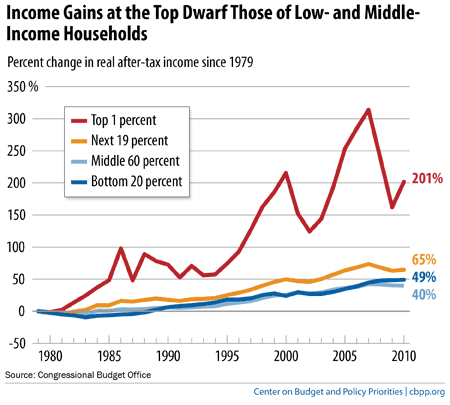más allá de los números
Things Looking Up at the Top, New Figures Show
Incomes at the top have started rebounding from their sharp decline in the financial crisis and Great Recession, new figures from the Congressional Budget Office confirm — just as they rebounded strongly from the dot-com collapse of the early 2000s (see graph). My latest post for U.S. News & World Report’s Economic Intelligence blog charts the growth in income inequality in recent decades, which President Obama discussed in Wednesday’s speech on the economy.

My post lays out three broad themes:
1. The loss of shared prosperity. For a generation after World War II, incomes across the distribution scale grew at nearly the same pace — roughly doubling between the late 1940s and the early 1970s. Thereafter, income disparities began to widen, with income growing much faster at the top than in the middle or bottom.
2. Widening inequality since the 1970s. From 1979 to 2007 (just before the financial crisis and Great Recession), average after-tax income rose at all levels but most dramatically at the top, where the income of the top 1 percent quadrupled. The increases in the middle 60 percent and bottom 20 percent were much smaller.
3. Very high concentration at the very top. The share of before-tax income that the richest 1 percent of households receive — which had been declining steadily from the 1930s into the 1970s — has been rising since the late 1970s and, in the past decade, has climbed to levels not seen since the Roaring Twenties. The vast majority of the increase reflects the rising share of before-tax income of the top 0.5 percent.
I conclude:
The sharp rise in inequality might be less disturbing if it was accompanied by substantial income mobility, so that people who began life in low- and moderate-income households could generally expect to move up and most people at the bottom were there because they were experiencing a temporary spell of bad economic luck. But as the President noted in his speech, the evidence on economic mobility is just as troubling as the evidence on rising inequality, especially bottom up mobility.
There’s plenty of room to debate the best policies to address the challenges that rising inequality and reduced mobility pose for the American dream. But, the data make clear that it’s a debate we should be having.
Click here for CBPP’s guide to historical trends in income inequality.
